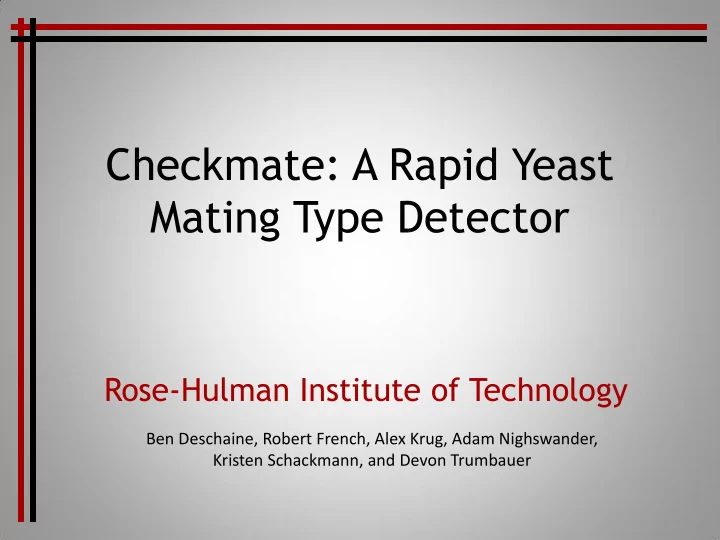

Checkmate: A Rapid Yeast Mating Type Detector Rose-Hulman Institute of Technology Ben Deschaine, Robert French, Alex Krug, Adam Nighswander, Kristen Schackmann, and Devon Trumbauer
Purpose Goal: To develop a system that significantly decreases the time required to determine the mating type of yeast ( Saccharomyces cerevisiae ) haploids Application: To facilitate basic research and commercial applications that utilize yeast
Yeast Life Cycle http://commons.wikimedia.org/wiki/File%3AYeast_lifecycle.svg
Current Mating Type Test
Checkmate Mating Type Test
Benefits of Checkmate Method • No need for complementary auxotrophic mutations for diploid selection • Significantly decreases time required for mating test Checkmate! Traditional (~4 hrs) (~40 hrs) Start Mate haploids ( ~4 hrs ) Select diploids ( ~36 hrs )
Ajo-Franklin et al., Rational Design of Memory in Eukaryotic Cells
Construct Design • Bifunctional promoter is bound by Ste12 and LexA • Fluorescent domains act as reporters • LexA DNA-binding domain and VP64 activator together act as a transcription factor • Nuclear localization sequence sends the heteroprotein into the nucleus
Molecular Animation of Circuit http://www.youtube.com/watch?v=i1yUjHN9Fyg
Project Obstacles • After considerable effort, we determined that the first vendor’s protocols were not amenable to producing the construct we desired • After placing an order with a second vendor, we found that the construct requested was much more difficult to synthesize than anticipated, so it was not received until mid-September
Collaboration with NTNU Promoter Characterization • BBa_K822000 : lactate promoter from E. coli Fused to BBa_E0422: cyan • fluorescent protein • Constructs were sequenced and verified • Tested 100 mM lithium lactate with controls Results were negative •
Kofahl and Klipp, Modeling the dynamics of the yeast pheromone pathway
Differential Models
Numerical Analysis: Numerical Analysis: Gamma = 100 Epsilon = 1000 200 120 100 150 80 Protein Protein 100 60 40 50 20 0 0 0 20 40 60 80 100 120 0 20 40 60 80 100 120 Signal Signal
Outreach • Aimed at two different age groups • Long-lasting impact • Affects the community as well as a larger audience
Exploring DNA at the Design Table
Hands-on Experience at the Lab Bench
BioPioneer: Synthetic Biology edition is aimed at teaching players about synthetic biology as they play it. Players manage a laboratory to create a DNA strand that codes for the solution to one of the six major world problems: Malaria, Environmental Clean-Up, World Back Hunger, Alternative Energies, HIV Pandemic, and Malnutrition. Front Back Front
Players accomplish this through the use of lab personnel and 3 main strategies: Each paper is different, Lab personnel allow the and some can add to the player to use actions to player’s knowledge pool. work the equipment or Others have special write a paper. They also abilities that optimize count towards the player’s equipment or give the knowledge pool. player a new ability. Equipment manipulates the DNA sequence to help it match the Each lab has a special technique used in random sequence. synthetic biology that helps them create their DNA sequence.
High School iGEM Competition
Questions?
Recommend
More recommend